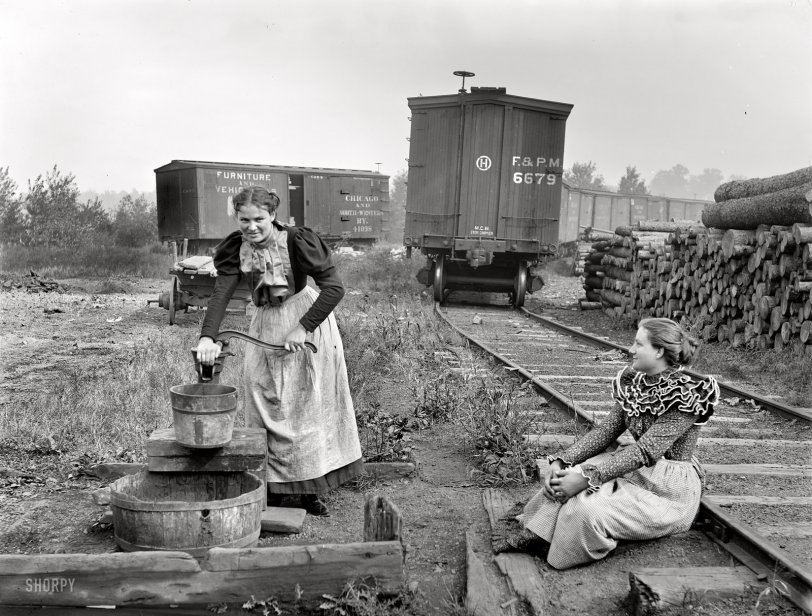


Framed or unframed, desk size to sofa size, printed by us in Arizona and Alabama since 2007. Explore now.
Shorpy is funded by you. Patreon contributors get an ad-free experience.
Learn more.

- Baldwin 62303
- Baldwin VO-1000
- Cold
- No expense spared
- Tough Guys
- Lost in Toyland
- And without gloves
- If I were a blindfolded time traveler
- Smoke Consumer Also Cooks
- Oh that stove!
- Possibly still there?
- What?!?
- $100 Reward
- Freeze Frame
- Texas Flyer wanted
- Just a Year Too Soon
- WWII -- Replacing men with women at the railroad crossing.
- Yes, Icing
- You kids drive me nuts!
- NOT An Easy Job
- I wonder
- Just add window boxes
- Icing Platform?
- Indiana Harbor Belt abides
- Freezing haze
- Corrections (for those who care)
- C&NW at Nelson
- Fallen Flags
- A dangerous job made worse
- Water Stop
Print Emporium
Lots of Pulp: 1890s

Appleton, Wisconsin, circa 1890s. "Girls of the paper mills." Evidently taking a water break. Detroit Publishing Company glass negative. View full size.
My German Wife
The girl on the right looks spooky similar to my German wife. With the photo being taken in Wisconsin in the 1890s; I suspect we might be looking at German immigrant girls.
I Guess......
I'm the only one who thinks that's an odd place for a well & pump.
Mary & Martha
How can I get the e-mail address of the cutie on the right?
Ruffles and Flourishes
It takes a spirited woman to add a five-layer ruffled collar to a utilitarian calico shirtwaist. Who says you can't look stylish working in a paper mill?
Comfortable in the real world
I've been wondering why the "factory girls" were usually prettier than the aristocratic women. This picture may give an answer: the "factory girls" were comfortable and confident about reality.
Even though the photo is clearly posed, you can tell the girl on the left knows how to use a pump and isn't afraid to get wet; the girl on the right knows that the train won't be moving soon, and isn't afraid to let ordinary dirt touch her dress.
Fancy
Compared to the dress of folks we have seen in previous working environments, these two ladies look like they are preparing to attend a fancy ball. And look at those delicious Midwestern complexions.
No brakes
Or I should say no air brakes on that F&PM (Flint & Pere Marquette) boxcar, as evidenced by the lack of an air hose next to the coupler. The F&PM operated a Lake Michigan carferry service from Ludington to Manitowoc just down the line from Appleton. It was later simply called the Pere Marquette, and in 1947 was merged into the Chesapeake & Ohio, which is now part of CSX.
Come on.....
This is really a recent photo taken with girls wearing period clothes.
What a great photo, and excellent quality. Like stepping into a time machine. Yet I doubt anything in this photo exists today, except maybe the rail line.
One of them doesn't seem to be working too hard at all.
F.&P.M.
The F&PM was the Flint & Pere Marquette, later just Pere Marquette. The car has a newfangled knuckle coupler, labelled "MCB" for Master Car Builder's Association. However there doesn't seem to be an air brake hose. Also notice the poling pockets on the end beam -- metal circles. A wooden pole could be placed from these to similar pockets on a locomotive on a parallel track, enabling the locomotive to push the car. This was a dangerous practice for the crewmen, who had to hold the pole in place. In those days though, railroad workers were considered more or less disposable.
The circled "H" indicates that this is the handbrake end of the car, I think.
Ladylike? Yes, but
both of them have hands that could crack walnuts.
Memory Failing
I could have sworn that "Girls of the Paper Mills" was a Playboy photo feature in the early 1970's.
What are you going to believe?
Despite the calm and easygoing faces these two lasses are exhibiting, it's hard to not to notice how ruffled they are.
If you look closely....
you can see Brett Favre in the open boxcar, probably hiding from training camp.
Furniture Cars
My grandfather, who was an engineer born into a family of railroaders, once explained to me that "Furniture Cars" existed to ensure consumer goods weren't damaged upon arrival, as in those days anything could be hauled in a boxcar, from raw cow hides to coal to the occasional load of livestock. I know I wouldn't want a couch that was shipped to me in a boxcar that recently held coal!
Furniture cars
Furniture cars were substantially larger (40 or even 50 feet long) because furniture was a relatively light load. The average car of the 1890s was 34 feet long and held maybe 30 tons. Putting a full load of grain, for instance, into a furniture car would badly overload it, but a 50-foot car of furniture was unlikely to tax the weight limit for the wood frame. As boxcars got stronger, the need to have specialty cars for larger but lighter loads decreased. But what you do see, incidentally, is the growth of automobile boxcars, which are marked by extra large or double doors.
Note also the F&PM car on the right does not have an airbrake hose.
Nice looking girls
They really don't look like the type to be working hard in a paper mill.
Furniture cars
Both this and the recent Buffalo picture show rail cars dedicated to furniture transport. As far as I know those types of cars haven't existed in decades.
























On Shorpy:
Today’s Top 5